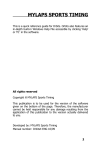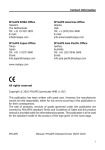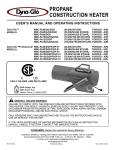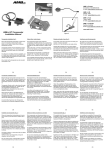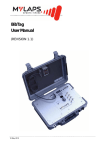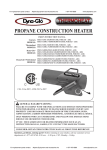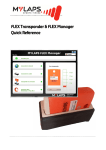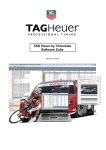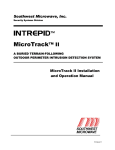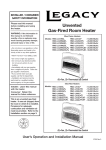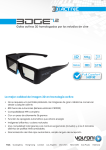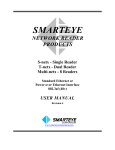Download MYLAPS 2 way decoder manual
Transcript
Contents Contact Information.......................................................................... 1. Getting started............................................................................. 1.1 System overview................................................................. 1.2 What is in the box............................................................... 1.3 Required items................................................................... 2. TnetX detection loop installation.................................................... 2.1 Positioning......................................................................... 2.2 Installation of the TnetX detection loop................................ 3. Connecting the TnetX Host............................................................ 3.1 Connection sequence.......................................................... 3.2 TnetX detection loop testing................................................ 4. Operating the TnetX Host.............................................................. 4.1 Description of the TnetX Host............................................. 4.1.1 Front panel view....................................................... 4.1.2 Rear panel view........................................................ 4.1.3 Display information................................................... 4.2 Operating the TnetX Host................................................... 4.2.1 Button functions....................................................... 4.2.2 Menu structure......................................................... 5. Information menu......................................................................... 5.1 Menu structure.................................................................. 5.2 Default display................................................................... 5.3 Last passing...................................................................... 5.4 Network............................................................................ 5.5 MAC address/ serial number............................................... 5.6 Firmware.......................................................................... 6. Advance menu............................................................................. 6.1 Menu structure................................................................. 6.2 Data line.......................................................................... 6.3 General............................................................................ 6.4 Network........................................................................... 7. Troubleshooting........................................................................... 7.1 TnetX Host not listed in Orbits........................................... 7.2 No TnetX Communicator detected by TnetX Host................ 7.3 Specific TnetX Communicator not detected by TnetX Host.... 8. Technical specifications................................................................. 9. Guarantees & Warranties.............................................................. 10. CE regulations............................................................................ 2 3 3 4 4 5 5 5 7 7 7 9 9 9 9 10 10 10 11 12 12 13 13 14 14 14 15 15 16 16 17 19 19 19 19 20 21 22 1 Contact Information MYLAPS EMEA Office Haarlem Haarlem The Netherlands Tel: +31 23 529 1893 E-mail: [email protected] MYLAPS Americas Office Atlanta USA Tel: +1 (678) 816 4000 E-mail: [email protected] MYLAPS Japan Office Tokyo Japan Tel: +81 3 5275 4600 Email: [email protected] MYLAPS Asia Pacific Office Sydney Australia Tel: +61 (0)2 9546 2606 Email: [email protected] www.mylaps.com All rights reserved Copyright © 2008-2010 MYLAPS Sports Timing (previously AMB i.t.) This publication has been written with great care. However, the manufacturer cannot be held responsible, either for any errors occurring in this publication or for their consequences. The sale of products, services of goods governed under this publication are covered by MYLAPS’s standard Terms and Conditions of Sales and this product manual is provided solely for informational purposes. This publication is to be used for the standard model of the product of the type given on the cover page. MYLAPS 2 Manual: MYLAPS 2-Way decoder/02-2010 1.Getting Started 1.1 System overview Principle of the MYLAPS Display Onboard System (previously known as TnetX system): The Timing System sends the official timing and position information, generated by the Personal MYLAPS Transponders, to the MYLAPS 2-Way Decoder system. The Communicators installed on the vehicles receive this information via the Communication detection loop installed 50m (165ft) behind the Timing loop and update the Onboard Displays. 3 1.2 What is in the box 1.3 Required items In order to complete the set-up you also need some other required items that are not delivered with the MYLAPS 2-Way Decoder: • 2-Way Communication detection loop end box (ref. 30r011) • MYLAPS coax cable with connection box (available in 20m/65ft, 50m/165ft or 100m/330ft) • MYLAPS Timing System: - MYLAPS CAR/BIKE decoder and Personal CAR/BIKE Transponders* - MYLAPS MX decoder and Personal MX transponders.* • 10/100 base-T hub • Orbits4 SP1 (ref. 25R015) • MYLAPS Onboard Display Plug-in for Orbits4 SP1 (ref. 25R019) * If you want to use Onboard Display system combined with your TranX2.5 Single or Extended decoder or your AMBmx decoder, please contact your nearest MYLAPS office for more information. 4 2. 2-Way Communication detection loop installation All wiring of the 2-Way Communication detection loop must be installed according to the drawing below in order to avoid a serious degradation in the performance of the system. Make sure no metallic items (such as rails and cables) are close to the TnetX detection loop. The distance between the detection loop of the timing system and the TnetX detection loop should be at least 50m (165ft). 2.1 Positioning • All wiring of the 2-Way Communication detection loop must be installed according to the drawing below in order to avoid a serious degradation in the performance of the system. • Make sure no metallic items (rails or cables) are close to the detection loop. • The distance between the detection loop of the timing system and the 2-Way Communication detection loop should be at least 50m 2.2 Installation of the 2-Way Communication detection loop a) Cut the slots in the track a maximum of 2cm deep and 60cm apart. Make sure the slots are clean and dry. This will ensure a perfect seal when the silicon is applied after the installation of the wiring. b) Put the End box first, then place the wires of the 2-Way Communication detection loop in the slots. c) Widen the slot with a chisel where the connection box of the loop will be installed, cut a slot for the coaxial cable. Place the connection box and the coaxial cable in the slot. 5 d) e) f) g) h) i) When all wires are installed, cut the excess length of the detection loop wires. Put the heat shrinkage sleeve over a detection loop wire end. Solder the loop wire to the short wire end of the connection box. When soldering the wires together, the solder should flow through the entire connection and not only around it. Put the shrinkage sleeve over the soldered connection and hold it over a heat source to shrink the sleeve. Test the 2-Way Communication detection loop (see paragraph 3.2) Fill the slots with silicone. Be sure not to overfill the slots and that the silicone is fully under the surface of the track, otherwise tires may pull out the silicone. If any silicone spills out of the slot, remove the excess silicone by scraping the top with a small piece of cardboard. This also ensures that the silicone is pressed into the slot for a perfect seal. LEARNED BY EXPERIENCE If you wish, you may pad the slots with a backing rod or nylon cord before sealing the slot with silicone. This helps to prevent the excessive use of silicone and is also useful when pulling out the silicone if the TnetX detection loop has to be replaced. Silicone types There is a wide variety of silicone types available in hardware stores; it is important that the right type is used. Silicone that can withstand different temperatures as well as both wet and dry conditions (since weather situations can vary) should be used. If you are unsure, check the specifications of the silicone. The following types of silicone have been shown to yield lasting results and are recommended by MYLAPS: • Dow Corning 890SL is a self-leveling silicone kit. It is applied as a liquid and fills the slot completely. • Purflex is a polyurethane-based silicone that retains its elasticity under a wide range of temperatures. 6 3. Connecting the 2-Way Decoder The 2-Way Decoder is a precision instrument. Therefore, please handle it with care and keep the 2-Way Decoder out of direct sunlight and avoid high humidity. Take special precautions in case of thunderstorms by disconnecting all cables (coax, Ethernet and Main power) from the 2-Way Decoder and the Timing System. Nearby lightning strikes can damage the devices when these cables are connected. 3.1 Connection sequence 1. 2. 3. Connect the 75 Ohm double-shielded coaxial cable connected to the 2-Way Communication detection loop to the 2-Way Decoder. The distance between this loop and the 2-Way Decoder should not exceed 100m Connect the 2-Way Decoder to your Local Area Network(LAN) shared with the Timing Computer and the Start/Finish Decoder. The distance between the 2-Way Decoder and your LAN should not exceed 100m; Connect the supplied VDC adapter to the 2-Way Decoder and the mains power. It is recommended to connect the VDC adapter to mains through a UPS (Uninterruptible Power Supply) to avoid any interruption of power supply to the Host. 7 3.2 2-Way Communication loop testing Once the loop has been installed, it should be tested to ensure that it is functioning correctly before sealing the slots. We also recommend repeating the same procedure at the start of each race event. You can determine if your loop is functioning correctly by doing the following tests: a) Connect the detection loop to the TnetX Host and computer running the Orbits4 SP1 Timing software. b) Check the background noise, updated every five seconds in the timing software. The measured background noise level value should be between 0 and 40 points. A higher value may indicate interference by other electrical equipment in the area or a bad loop installation. Try switching off any suspected equipment or removing nearby objects and check for improvements. Especially at night, short-wave radio transmitters may cause an increased background noise. c) On a correctly installed 2-Way Communication loop, the signal from the 2-Way Communicator should be picked up at the same height along the entire 2-Way communication loop. d) Check the signal strengths of the 2-Way Communicator as they are picked up by the system during a test with vehicles: • A good loop will yield consistent 2-Way Communicator signal strengths of at least 100 points with a hit rate of at least 10 points. • The hit rate may vary depending on the speed of the 2-Way Communicator passings (slower passings yield higher hit counts), but the signal strength should be consistent (< 10 points variation). Note: Incorrectly installed Communicators will also show low signal strengths. See MYLAPS Onboard Display Kit User manual for the correct installation instructions. 8 4. Operating the TnetX Host 4.1 Description of the 2-Way Decoder 4.1.1 Front panel view a) Display b) Select button c) Set button 4.1.2 Rear panel view a) Communication to the 2-Way loop b) Network connector (10/100) c) Power connector (DC) 9 4.1.3 Display information The display of the 2-Way Decoder will/can show the following information: a) Date/time b) Connection information c) Name of the dataline d) Communication status with Orbits4 SP1 e) Amount of messages in the queue waiting to be sent to a 2-Way Communicator f) Data communication indication between a 2-Way Communicator and the 2-Way detection loop g) Background noise indication 4.2 Operating the 2-Way Decoder There is no on/off switch on the 2-Way Decoder, therefore connecting it to the mains will automatically switch it on. Communicator passings will be registered after the initialization sequence (takes about 15 seconds after connection to the mains). 4.2.1 Button functions There are two control buttons and they are located at the front panel of the TnetX Host. The buttons are pressed separately to cycle through modes and select mode options. Set Button Next Button Press Set Press Next 10 to access a menu. to access the next menu. 4.2.2 Menu structure There are two menus: • information menu • advanced menu The information menu provides the general settings of the decoder • Navigation to the next screen by pressing the Set button; • The display returns to the default display after 10 seconds of inactivity; • The information is read only: The 2-Way decoder settings cannot be changed in this menu; • The information menu is described in Chapter 5. The advanced menu • Settings of the 2-Way Decoder can be changed in the advanced menu; • The advanced menu is described in chapter 6. 11 5. Information menu 5.1 Menu structure 12 5.2 Default display Information in standby mode: a) Date and time of the day b) Name of the data line c) Amount of messages in the queue d) Background noise level e) Communication status with Orbits4 SP1 Information when a 2-Way Communicator passes the 2-Way detection loop: • • The 2-Way Decoder sends information to the 2-Way Communicator The 2-Way Decoder receives information from the 2-Way Communicator 5.3 Last passing • • • • • • Comm: Number of the last detected 2-Way Communicator (Paired Personal Transponder Number) St: Strength of the last received signal Hit: Amount of received hits Link: Maximum of hits for sending results from the 2-Way decoder to the 2-Way Communicator Sent: Amount of messages sent to 2-Way Communicator Recv: Amount of messages received from 2-Way Communicator 13 5.4 Network • • IP address How the IP address is obtained: possible values DHCP, AIPIPA, Static 5.5 MAC address/serial number • Serial number of the 2-Way Decoder 5.6 Firmware version • • • 14 Type of Decoder Active firmware version: Firmware version used by the 2-Way Decoder Passive firmware version: See paragraph 6.3 for more information 6. Advanced menu 6.1 Menu structure Navigation in the menu • To select the highlighted field, press the Set button • To scroll to the next field, press the Next button 15 • To access the upper menu, press next highlight , then press and scroll down to . 6.2 Data line menu The settings below do not influence the performance of the 2-Way Decoder but can be retrieved by Orbits4 SP1 for easier track setup. Settings related to the detection loop can be viewed/modified within the Data line submenu: • Name: Name of the 2-Way Decoder according to the detection loop connected. The name will continuously appear on the display of the 2-Way Decoder. Possible Values S/F, Start, Finish, IP, Pit S/F, Pit In, PitOut, Control, Speed. The default value is S/F; • Index: The Index can be set in a Multiloop Timing System to define the order of an intermediate point. The default value is 1; • Main/Backup: Select the role of the 2-Way Decoder. The default value is Main; 6.3 General menu The general 2-Way Decoder settings can be viewed/modified within the general submenu: • Clock: Date: Verify/change the date information. Time: Verify/change the time information Note: The date and time information on the 2-Way Decoder is purely display information and will not be used in the data sent to the 2-Way Communicators. To set your 2-Way Decoder to a specific time in seconds: First select the time in hours and minutes that you wish to set the 2-Way Decoder on. After this, the 2-Way Decoder will ask you to select SET. At the exact moment SET is selected, 16 the 2-Way Decoder clock will start at the selected time from zero seconds. For example: the new time setting for the 2-Way Decoder is 11.15; when you press SET, the 2-Way Decoder clock will start counting at the exact time, 11h:15m:00s. • Contrast: This setting allows to adjust the contrast settings of the display of the 2-Way Decoder. Note that the contrast of the display is also related to the temperature of the environment. • Factory defaults: Reset the settings of the 2-Way Decoder to the original settings. • Firmware: Displays the version of the active and passive internal software of the 2-Way Decoder. The switch firmware option offers to revert back to the previous version of the firmware. Default Passive is empty, it receives a value after performing a firmware update. 6.4 Network menu The 2-Way Decoder’s network settings can be viewed/modified within the Network submenu: • Automatic: Automatic Network configuration of the 2-Way Decoder. To have the IP address of the 2-Way Decoder set automatically. The setting can be “on” or “off”. • When Automatic is “on” (default setting): • The 2-Way Decoder will first try to get an IP address from the DHCP server. Obtaining the address from the DHCP server can take up to 60 sec. • If the DHCP server is not found on the Network or not available, the 2-Way Decoder will use an IP address via APIPA to automatically configure itself with an IP address from a range from 169.254.0.1 through 169.254.255.254. The 2-Way Decoder also configures itself with a default subnet mask of 255.255.0.0. The 2-Way Decoder will use the APIPA IP address until a DHCP server is found on the Network or becomes available. • When Automatic is set “off”: • The IP Address of the 2-Way Decoder will have to be defined on the 2-Way Decoder via the IP Address menu in the network sub menu. 17 • IP address: First set Automatic to Off to access the menu. The IP address of the host can be manually set in this menu. • Subnet mask: First set Automatic to Off to access the menu. The Subnet mask of the host can be manually set in this menu. • Gateway: First set Automatic to Off to access the menu. The IP Address of the Gateway can be manually set in this menu. • DNS: First set Automatic to Off to access the menu. The IP Address of the DNS server can be manually set in this menu. MYLAPS Sports Timing highly recommends to keep the Network setting to the default value (Automatic “on”) as this avoids IP conflicts or communication problems due to a wrong Network setting. 18 7. Troubleshooting 7.1 2-Way Decoder not listed in Orbits • Make sure that all connectors are firmly in place; • Make sure the 2-Way Decoder is powered on; • Make sure you have waited at least 60 seconds after having powered on the TnetX Host; • Press the Refresh button in the 2-Way Decoder Connection Wizard in Orbits; • Check that the green light on the Network connector on the 2-Way Decoder is on; • Check that the light on the Network adapter of the timing computer is on; • Ping the IP address of the Host from the timing computer. Information about the ping command can be retrieved on the MYLAPS support website. • If ping is successful, make sure the IP address of the 2-Way Decoder is in the same range: For example if the IP address of the timing computer is 192.168.10.10, make sure the IP address of the 2-Way Decoderstarts with 192.168.10.xx; • An unsuccessful ping command means a faulty network connection or configuration. Check the cabling and the network settings on the 2-Way Decoder. 7.2 No 2-Way Communicator detected by 2-Way Decoder • Check all cabling and connections between the 2-Way communication detection loop and the 2-Way Decoder; • Make sure Orbits4 SP1 is started. 7.3 Specific communicator not detected by 2-Way Decoder • Check if the Personal Transponder Number of the competitor/vehicle is detected in Orbits; • Check the mounting position of the 2-Way Communicator. The mounting information is documented in the MYALPS Onboard Display Kit User Manual. • Have the competitor check if this specific 2-Way Communicator receives power (continuous green LED); 19 8. Technical specifications 2-Way Decoder • Dimensions: 180x160x45mm/7x6.3x1.8 inch • Weight: 720g/1.6 lb • Host Clock stability: 0.5 ppm • Time of day clock stability (host off):+/- 25 ppm • Time of day clock stability (host on):+/- 0.5 ppm • Time of day clock resolution: 1 sec. • Maximum track width: max. 20m/66ft • Operating temperature range: -15 to 50 C/-4 to 122 F • Humidity range 10 % to 90 % relative • Operating voltage range 10 to 14.4 V, typical 12V • Power consumption max. 400 mA @ 12V, typical 300 mA • Interfaces 10/100 BaseT • Network connection DHCP client, APIPA, Static IP Specifications are subject to change without notice. 20 9. Guarantees & Warranties MYLAPS, formerly AMB, warrants that, for a period of three (3) years from the date of shipping the decoders and the MYLAPS MX Rechargeable Power (AMBmx), MYLAPS RC DP (AMBrc DP), MYLAPS KART DP (TranX160 DP), MYLAPS Kart Rechargeable Power (TranX160), MYLAPS Car/Bike DP (TranX260 DP), MYLAPS Car/Bike Rechargeable Power (TranX260), MYLAPS Car/Bike Pro (TranX Pro) transponders covered by this warranty with defects, as determined solely by MYLAPS, caused by faulty materials, workmanship or design will be repaired or replaced, unless such defects were the result of any of the following: shipping; improper installation, maintenance or use; abnormal conditions of operation; attempted modification or repair by the customer or any third party; use of the goods in combination with other items; or an act of God. If repair or replacement of the goods is not possible or economical for MYLAPS, MYLAPS may, at its option, refund the purchase price of the goods or deliver replacement goods at its sole discretion. MYLAPS’s liability shall be strictly limited to replacing, repairing or issuing credits at its option. MYLAPS warrants that, for a period of two (2) years from the date of shipping the ProChip, MYLAPS Kart Fixed Power (TranX140) and the MYLAPS RC Rechargeable Power (AMBrc) transponders covered by this warranty with defects, as determined solely by MYLAPS, caused by faulty materials, workmanship or design will be repaired or replaced, unless such defects were the result of any of the following: shipping; improper installation, maintenance or use; abnormal conditions of operation; attempted modification or repair by the customer or any third party; use of the goods in combination with other items; or an act of God. If repair or replacement of the goods is not possible or economical for MYLAPS, MYLAPS may, at its option, refund the purchase price of the goods or deliver replacement goods at its sole discretion. MYLAPS’s liability shall be strictly limited to replacing, repairing or issuing credits at its option. MYLAPS warrants that, for a period of one (1) year from the date of shipping the MYLAPS Onboard Display kit (TnetX Display Kit) covered by this warranty with defects, as determined solely by MYLAPS, caused by faulty materials, workmanship or design will be repaired or replaced, unless such defects were the result of any of the following: shipping; improper installation, maintenance or use; abnormal conditions of operation; attempted modification or repair by the customer or any third party; use of the goods in combination with other items; or an act of God. If repair or replacement of the goods is not possible or economical for MYLAPS, MYLAPS may, at its option, refund the purchase price of the goods or deliver replacement goods at its sole discretion. MYLAPS’s liability shall be strictly limited to replacing, repairing or issuing credits at its option. MYLAPS warrants that, for a period of one (1) year from the date of shipping, all other goods covered by this warranty with defects, as determined solely by MYLAPS, caused by faulty materials, workmanship or design will be repaired or replaced, unless such defects were the result of any of the following: shipping; improper installation, maintenance or use; abnormal conditions of operation; attempted modification or repair by the customer or any third party; use of the goods in combination with other items; or an act of God. If repair or replacement of the goods is not possible or economical for MYLAPS, MYLAPS may, at its option, refund the purchase price of the goods or deliver replacement goods at its sole discretion. MYLAPS’s liability shall be strictly limited to replacing, repairing or issuing credits at its option. 21 If the requirements set forth above and described under Remedies and Damages are not complied with, our warranty/guarantee shall not apply and we shall be discharged from all liability arising from the supply of defective goods. EXCEPT AS EXPRESSLY PROVIDED IN THIS SECTION, MYLAPS MAKES NO REPRESENTATIONS OR WARRANTIES OF ANY KIND, NATURE OR DESCRIPTION, EXPRESS OR IMPLIED, INCLUDING WITHOUT LIMITATION, ANY WARRANTY OR MERCHANTABILITY, FITNESS OF THE GOODS FOR ANY PARTICULAR PURPOSE, OR NONINFRINGEMENT, AND MYLAPS HEREBY DISCLAIMS THE SAME. Remedies and Damages 1. MYLAPS shall not incur any liability under the above warranty unless: i) MYLAPS is promptly notified in writing upon discovery by the customer that such goods do not conform to the warranty, and the appropriate invoice number and date of purchase information is supplied; ii) The alleged defective goods are returned to MYLAPS carriage pre-paid; iii) Examination by MYLAPS of goods shall confirm that the alleged defect exists and has not been caused by unauthorized use (including, without limitation, the use of an AMB decoder with non-MYLAPS hardware) misuse, neglect, method of storage, faulty installation, handling, or by alteration or accident; and iv) With respect to MYLAPS decoders, customer has upgraded the firmware in its decoder within one month after MYLAPS has offered to provide customer with such upgraded firmware. 2. The customer acknowledges that the goods may include certain firmware imbedded therein. MYLAPS hereby grants a license to customer to use the imbedded firmware in an MYLAPS decoder, but only to the extent the decoder is used in connection with MYLAPS hardware. MYLAPS shall have the right to terminate the license immediately upon written notice to customer in case MYLAPS has a reasonable belief that customer at any time has used the MYLAPS decoder in connection with non-AMB hardware. Further, customer may not copy, compile, reverse compile, disassemble, translate, analyze, reverse engineer or attempt to reverse engineer the firmware, except as permitted by applicable law. 3. In addition, customer grants MYLAPS the option to repurchase any MYLAPS decoder if MYLAPS has a reasonable belief that customer has used the MYLAPS decoder in connection with non-MYLAPS hardware. The repurchase price shall be the fair market value on the date MYLAPS provides notice to customer that it intends to repurchase the decoder. The above mentioned warranty/guarantee is irrespective of any rights granted to the buyer of MYLAPS equipment manufactured or sold by MYLAPS based on the laws of the Netherlands. Any correspondence regarding the above mentioned guarantee must be addressed to MYLAPS: MYLAPS EMEA OFFICE HAARLEM Zuiderhoutlaan 4 2012 PJ HAARLEM THE NETHERLANDS E-mail: [email protected] Fax: +31 23 529 0156 22 10. CE Regulations CE information: This device complies with the EMC directive 89/336/EEC. A copy of the declaration of conformity can be obtained at: MYLAPS Sports Timing Zuiderhoutlaan 4 2012 PJ Haarlem The Netherlands 23

























